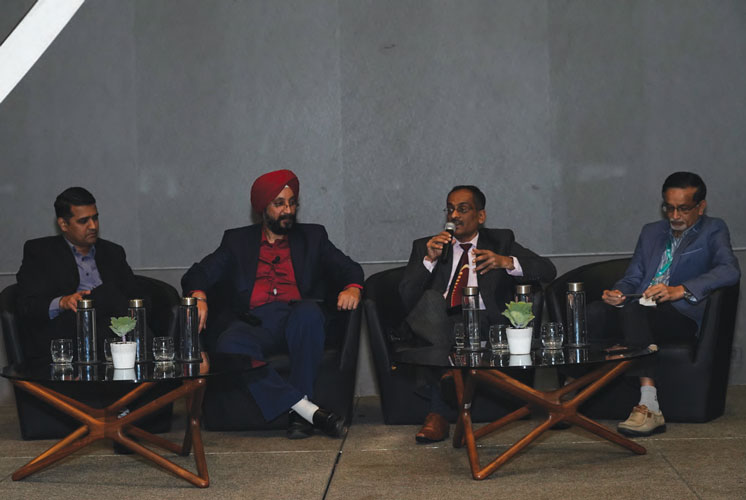From Left to Right :- Amit Phadke, Group Head – IT, Western Union; Upkar Singh, Director IT, FIS Global; Anand Aggarwal, CIO, Capital Trust Limited; Dr Raveendran N, CIO, Sakthi Finance
In this session, the panellists talk about how technology is enabling the BFSI sector in providing user-friendly services and solutions that ultimately lead them to securing and retaining a large user base.
The Banking, Financial Services and Insurance (BFSI) sector is at the forefront of riding the Digital Transformation wagon. Upkar Singh, Director IT, FIS Global asserts that it is owing to the fact that BFSI is a sector that caters to a majority of other sectors that it has adopted Digital Transformation at such a remarkable pace. It is estimated that India will become the 3rd largest domestic banking sector by 2050 after China and USA. With India’s working population set to increase over the next decade, the two things put together promise an exponential growth. Mobile wallet transactions are also expected to touch 90 Billion by 2022. Within the India perspective, this kind of increasing user base and the digital disruption in the emerging technologies, will lead to a Digital Transformation in the BFSI sector.
Referring to the chronology of transformation in the BFSI sector, Upkar Singh explains, “Initially it was easier for banks to get a decent user base. This was because earlier the criteria for selecting a bank were merely physical proximity to one’s residence. But today the users are looking at the kind of services banks are providing, the nature of customer touch they have and the solutions they are offering.”
The question that arises is why is Digital Transformation required for such an industry as the BFSI sector.
Addressing this question, Amit Phadke, Group Head – IT, Western Union, says, “Digital Transformation is about agility, scalability and reinventing the processes and established business models.” According to Amit Phadke, Digital Transformation does not necessarily have to be disruptive. But if you are not disruptive, you have to be conscious about the competition that might take over. Instead of the new-age technologies like Blockchain, Artificial Intelligence and Machine Learning which have not yet been adopted at a large scale, Amit endorses Cloud as an integral part of the digital journey of the BFSI sector.
Especially new channels opening up in the international economy, is connecting the BFSI sector of the world. Such integration requires replacing the on-premise traditional model with Cloud. This Cloud might not necessarily be public cloud. It can be private or hybrid too. However, it opens up Pandora’s boxes like security and control to be placed to reach the business objectives that both the companies have.
Amit Phadke adds, “The fact is that IT is no longer a backbone. It contributes to business directly. So, when you talk about Technology not necessarily being disruptive, it can be about reducing inefficiencies, improving customer experiences, putting up simple things in a different perspective. With customers becoming impatient today, you have to be on the top of things to retain them. This requires you to generate that kind of platform using the technology advancements that are happening. This is the leverage you need. This leverage will allow you to not just retain the customers you have bus also attract new customers.”
Contributing to the discussion Upkar Singh says, “With the new channels opening up, IT is playing a pivotal role in Digital Transformation. With new channels and personalized services you can make sense of the Technology usages in the industry and these directly cater to the end users.”
Moving on to the aspect of catering to the business value and end user satisfaction, Anand Aggarwal, CIO, Capital Trust Limited, talks about the necessity for the Non-Banking Financial Companies (NBFC) to have a differentiating factor that sets them apart from the competition in the market. Anand finds this differentiator in Transparency of operations that an NBFC has to offer to its clients.
“For a client, why should s/he go to a particular NBFC or another. The differentiator would be how transparent you are to the customer. What kind of services you are able to give to a customer? This is the differentiator that would decide when a customer wants to come to you or stick with you. If a customer is satisfied with their lender, why would they come to you? This is where technology plays a key role in this business,” says Anand Aggarwal.
The point is that your technology solution has to be extremely easy and user-friendly, because only then your consumer is going to be using it. Because if the consumer is not able to use it, then what is the purpose of making that particular piece of technology available to the user. So, when you develop certain initiatives, always take feedback from a controlled set of users before rolling it out.


